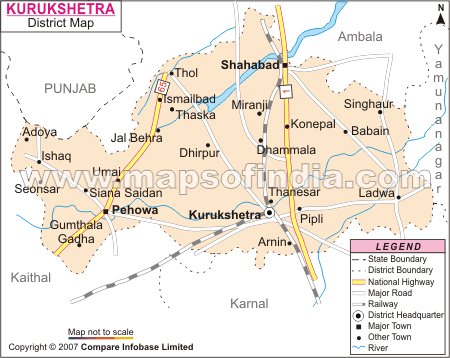Pehowa

Pehowa (पेहोवा) Pehawa (पेहवा) Pehewa (पेहेवा) (Peheva) is an ancient pilgrim centre [Tirath]. It is a tahsil headquarters of Pehowa in Kurukshetra District in Haryana. Its ancient name was Prithudaka (पृथूदक) (lit. meaning having extensive water.)
In Mahabharata
महाभारत में सरस्वती के तट पर प्राचीन तीर्थ के रूप में उल्लेख किया है. प्
- रथूदकमिति ख्यातं कार्तिकेयस्य वै नृप, तत्राभिषेकं कुर्वीत पितृदेवार्चाने रत: ....(वनपर्व 83 )
यहाँ पर आज भी अनेक प्राचीन मंदिरों के अनेक अवशेष हैं. यहाँ काफी पुरातत्व -विषयक सामग्री भी मिली है. महमूद गजनवी और मुहम्मद गौरी ने थानेसर को लूटने के समय पेहेवा को भी ध्वस्त कर दिया था. महाराणा रणजीत सिंह ने यहाँ के प्राचीन मंदिरों का जीर्णोद्धार करवाया था. [1]
Location
It is located 27 km west of Thanesar. Pehowa is located at 29°59′N 76°35′E / 29.98°N 76.58°E / 29.98; 76.58. It has an average elevation of 224 metres (734 feet).
Peheva inscription of Mahendrapala
Besides the Peheva inscription of Mahendrapala (Ep. Ind., Vol. I, p. 244) shows that the Karnal district was a part of the Gurjara empire even under that monarch, and if this was the territory taken away by Samkaravarman, the event must be placed in the reign of Mahendrapaladeva. But although Mahendrapaladeva might have been less successful in the west, he was more fortunate than his father in his eastern conquests. The Guneriya (गुणेरिया) and the Ramagaya (रामगया) inscriptions, dated respectively in the years 8 and 9 of Mahendrapala, seem undoubtedly to point out, as Mr. R. D. Banerji contended, that the province of Magadha had at last passed into the hands of the Pratiharas.
Villages in Pehowa tahsil
Adoya, Azmatpur, Bachki, Bakhli, Baloch Pura, Batheri, Bhainsi Majra, Bherian, Bhor Saidan, Bhorak, Bibipur Kalan, Bodha, Bodhni, Chanal Heri, Chhajupur, Chhawlan, Dhani Rampura, Dhulgarh, Diwana, Duniya Majra, Gangheri, Garhi Langri, Garhi Roran, Gledwa, Guldehra, Gumthala Garhu, Helwa, Ishaq, Jakhwala, Jal Behra, Jhinwarheri, Jorasi Kalan, Jorasi Khurd, Kakrala Gujran, Kalsa, Kamoda, Kanthala, Karah, Khanjarpur, Khanpur Roran, Kheri Shishgran, Khizar Pura, Lohar Majra, Lotni, Madaharan, Malakpur, Mandi, Mangna, Megha Majra, Mohanpur, Morthali, Muqimpura, Murtzapur, Naisi, Nikatpura Alias Garhi Singhan, Nimbwala, Nurpur Buchi, Pehowa (MC) Ramgarh Alias Rohar, Rattangarh Alias Kakral, Ruan, Saidpur Shahidan, Sandhola, Sandholi, Sansa, Sarsa, Sarusti Khera, Sataura, Seonsar, Shahpur, Shergarh, Shri Nagar, Siana Saidan, Singh Pura, Surmi, Tabra, Takoran, Talheri, Tangoli, Teokar, Thana, Thandran, Thaska Miranji, Theh Malbora, Tikri, Urnai, Urnaicha, Usmanpur, Zulmat,
Jat Gotras
Sheokand (श्योकंद) gotra Jats are scattered in this tahsil and have notable presence in the villages like Kakrod, Uchana and Jajanpur near Pehowa
History
References about Pehowa are found in Vaman Purana and the epic Mahabharata.
Mentioned as 'Prithudaka' in the epic Mahabharata named after the King Prithu who prayed for the salvation of his father's soul here. This is the site where tradition of Shraddha to fathers is offered. Legend has it that when the father of King Prithu was nearing his death, he wanted his son to fulfill just one wish of his. He wanted to breathe his last near the river Yamuna? Prithudak. Prithu arranged for the same, where his father departed the world of the mortals. Filled with remorse, Prithu sat staring at the river for many days at a stretch and made innumerable offerings to gods and observed fast too. The place where he is believed to have observed the fast for several days has been named Prithudak Teertha. Many ghats and temples have now been constructed to commemorate the king's sacrifice.
Another legend
Legend also says that it was created by Brahma himself.
Monuments
There is one Saraswati temple here,Its believed that sage Vishwamitra attained the title of "Brahmarishi' here. A temple dedicated to Lord Shiva is the major attraction of Pehowa; the temple has no 'linga' but a panch-mukhi (5 faced) idol of Lord Shiva has been installed, which is said to be only one of its kind in the state. Scores of pilgrims visit Pehowa to take a dip at the Saraswati Tank on the occasion of Chaitra Chaudas. Jyotisar, Aruna Teerth and Bhadrakali Temple are some other spots worth visiting around.
Excavations of various archeological sites in Haryana, including Pehowa, have evidence of pre-Harappan and Harappan culture. Findings of pottery, sculpture and jewellery in sites at Pehowa, have proved the historicity of the Mahabharata war.
The place boasts of existence from AD 882 but an inscription written on it states that it was actually built in AD 895. Another version suggests it's nascent days to be during the reign of King Mahenderapal.
Bhim Singh Dahiya[2] writes that Pahewa inscriptions of a Tomar family gives the names of their three generations, and says that the family sprang from a king Jaula, who lived ages ago.[3]
External links
- http://www.maplandia.com/india/haryana/kaithal/pehowa/
- http://www.fallingrain.com/world/IN/10/Pehowa.html
References
- ↑ Aitihasik Sthanavali by Vijayendra Kumar Mathur, p.576-577
- ↑ Jats the Ancient Rulers (A clan study)/Relationship with the Aryans, p. 102
- ↑ EI., Vol. I, p. 244; article by R. Hoernle in JRAS,1905.
Back to Jat Villages

